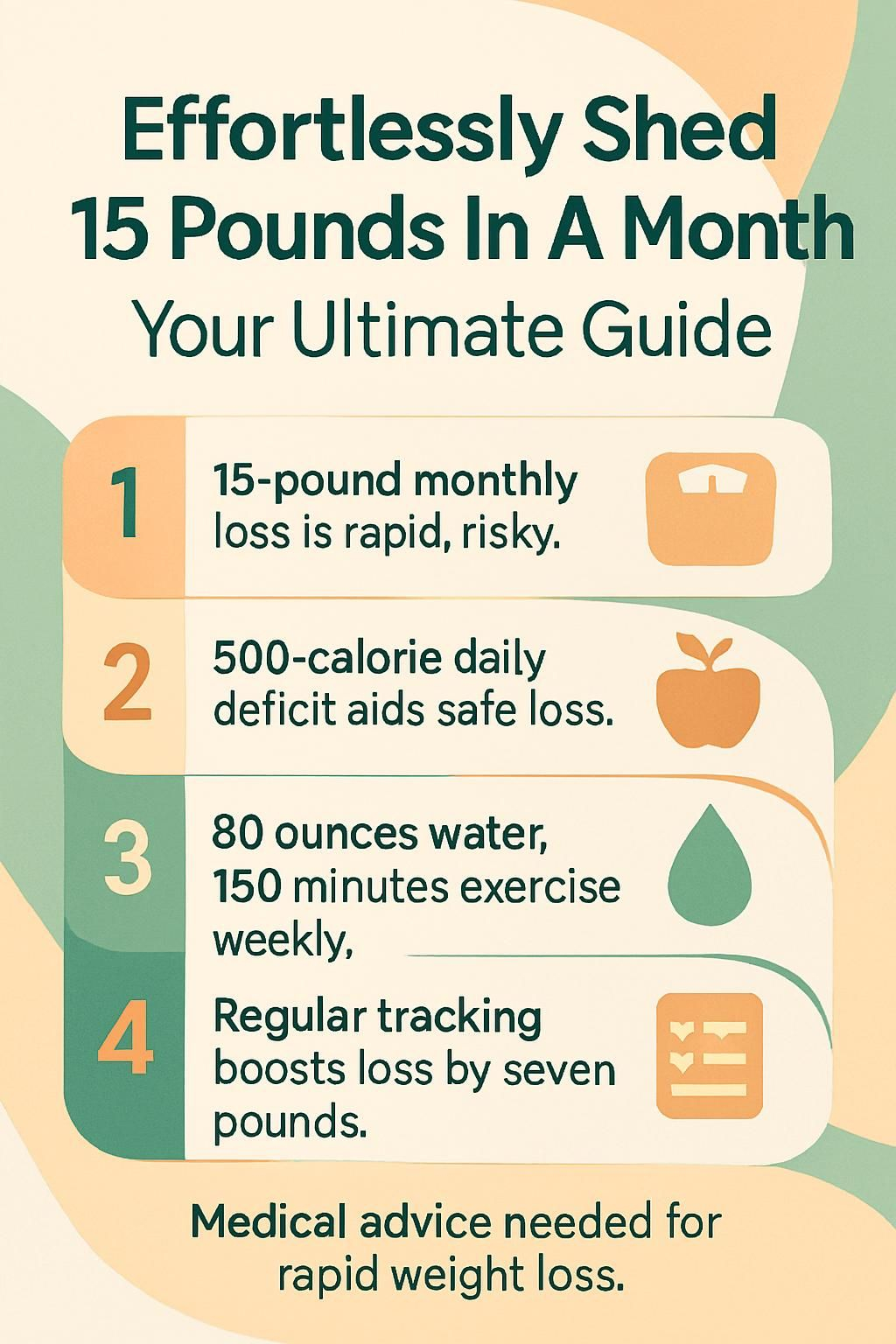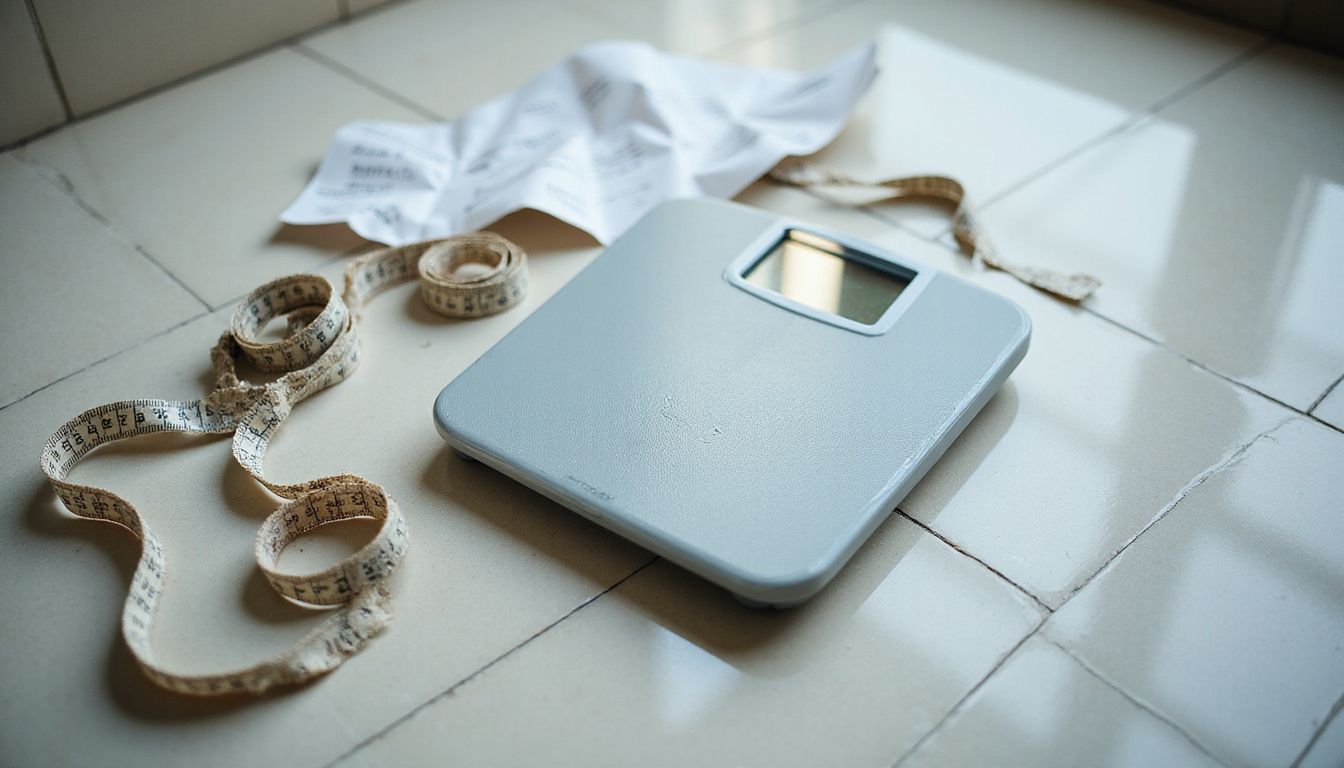Effortlessly Shed 15 Pounds In A Month: Your Ultimate Guide
Our Nutrition Assistant AI Suite will transform your body. You will lose fat, get toned, and build muscle. Gain confidence and optimal health.
Trying to lose 15 pounds in a month can feel overwhelming. Health experts agree that steady loss works best, yet many people still want faster change. This guide shows you how to build a safe calorie deficit, choose better foods, and set realistic weight loss goals so you can lose weight without harming your health.
Use the steps below to plan your month. You will learn how to eat, move, track progress, and adjust as needed.
Key Takeaways
- Most experts and the CDC suggest losing 0.5 to 2 pounds per week, so 15 pounds in a month is rapid and carries health risks.
- A daily calorie deficit of about 500 calories, tracked with tools like Lose It! or MyFitnessPal, helps many people lose about one pound per week safely.
- Choose nutrient-dense foods, drink at least 80 ounces of water per day, and aim for 150 minutes of exercise weekly to support steady progress.
- Consistent self-monitoring leads to better results. Studies show regular trackers lost up to seven pounds more on average.
- Seek medical guidance if you plan to lose more than two pounds per week, take supplements or medications, or manage conditions like diabetes.

Understanding Rapid Weight Loss and Its Safety

Rapid weight loss means losing a large share of body weight in a short time. The Centers for Disease Control and Prevention note that very fast loss can raise health risks. If you aim to lose 15 pounds in a month, you are targeting rapid loss. It can be done, but the tradeoffs are real.
What does rapid weight loss mean?
Health professionals define rapid weight loss as more than two pounds per week. This is faster than the CDC guidance of 0.5 to 2 pounds weekly for safer results.
To drop 15 pounds in 4 weeks, many people cut calories sharply or pair low-calorie diets with intense exercise. The National Institute of Diabetes and Digestive and Kidney Diseases notes that losing 15 pounds safely usually takes seven to thirty weeks. The timeline depends on your daily calorie needs, body mass index, activity level, and health conditions such as diabetes.
Big swings in body weight can affect muscle mass and energy. Rapid loss often pulls from both fat and lean tissue, which can slow progress later.
Losing more than two pounds per week falls into the category of rapid weight loss.
What are the health risks of losing weight quickly?
Fast loss can trigger a starvation response that slows metabolism. This makes it harder to keep weight off and increases the chance of regaining pounds.
Large calorie cuts may lead to dehydration, muscle loss, and vitamin or mineral gaps. Your body can break down skeletal muscle along with fat, which affects strength, bone support, and daily function.
During a strict low-calorie push in my teens, I felt constant fatigue and had trouble focusing in class. My legs felt weaker within weeks. Experiences like this are common when the diet is too severe.
Very low-calorie diets may also produce quick water loss instead of true fat loss. Real progress should come from fat loss while protecting muscle mass and health.
Setting Realistic Weight Loss Goals
Clear goals keep you focused and reduce stress. Aim for results that match your current weight, height, activity level, and health background. A steady plan lowers risk and improves your chance of keeping the weight off.
Why is a sustainable approach important?
Trying to lose 15 pounds in a month might sound exciting, but quick loss often rebounds. Many registered dietitians suggest gradual changes, aiming for 0.5 to 2 pounds per week through a healthy diet and regular exercise.
This pace helps you build habits you can keep, like balanced meals, strength training, and consistent steps. It also allows easier course corrections when life gets busy. In one dataset from Lose It!, users who picked modest plans, about 0.5 to 1 pound a week, reached goals in around 187 days.
In the past, I tried a very low calorie plan and lost weight fast. I gained it back fast too. Switching to steady tracking and weekly workouts helped me maintain my loss for the first time.
What factors affect how quickly you lose weight?
Metabolism matters. Basal metabolic rate, your calorie burn at rest, varies by age, sex, height, and weight. The USDA estimates many women maintain weight at 1,600 to 2,400 calories daily, and many men at 2,000 to 3,000.
Physical activity drives calorie burn. More intense workouts, such as high-intensity interval training, can help you lose fat faster than lighter activity alone. Life stages like pregnancy or lactation also change energy needs. Health needs, such as type 2 diabetes, can affect your pace and plan.
Consistency is the big lever. Following your plan closely usually beats short bursts of effort.
Consistency beats speed for safe weight loss.
How to Create a Caloric Deficit
A calorie deficit means you burn more than you eat. It is the core driver if you want to lose weight safely and keep it off. A weight loss calculator can help you estimate the right number for your goal.
How do I calculate my daily calorie needs?
Start with age, sex, weight, height, and activity level. The USDA suggests many women maintain weight between 1,600 and 2,400 calories each day. Many men maintain between 2,000 and 3,000.
Walking 1.5 to 3 miles per day is moderately active. Above 3 miles per day is active. Use a trusted weight loss calculator, such as NIDDK or Lose It!, to get a personal target. Many dietitians suggest cutting about 500 calories per day to lose roughly one pound per week.
Do not go below the minimum: 1,200 calories for women, 1,350 for nonbinary people, and 1,500 for men. Eating too little can slow metabolism, reduce muscle mass, and harm your health.
How can I reduce calories safely?
Lead with volume. Start meals with vegetables or fruit to fill up for fewer calories. Swap candy and sweetened beverages for whole grains, fresh fruit, or crunchy vegetables.
Limit alcohol to one drink per day for women and two for men. Alcohol adds empty calories and can slow fat loss.
Cutting 250 to 500 calories per day is a safe range for many people. Avoid skipping meals or severe restriction. These patterns can cause fatigue, muscle loss, or digestive issues. Some people like counting calories in an app; others use simple plate guides. Pick the method you can maintain.
The Role of Diet in Losing Weight
Food choices shape your progress. Nutrient-dense meals help you control calories without feeling deprived, which supports weight management across the month and beyond.
Why focus on nutrient-dense, whole foods?
Nutrient-dense foods give vitamins, minerals, protein, fiber, and healthy fats for fewer calories. Think fruits, vegetables, lean protein, beans, and whole grains. The Dietary Guidelines for Americans encourage these foods for a healthy weight.
Higher protein meals help preserve muscle mass during a calorie deficit. Fiber and water-rich foods increase fullness, which helps you stick to your plan. Cutting fast food and soft drinks can reduce sugar and total calories. Many people see steady loss after trading convenience food for home-cooked meals.
What are sample meals for effective weight loss?
Build your plate with produce, protein, and quality carbs. Start meals with vegetables or fruit to naturally curb intake.
- Breakfast: Scrambled eggs with spinach, berries on the side, and water or tea.
- Lunch: Grilled chicken, mixed greens, chickpeas, and vinaigrette; sparkling water.
- Dinner: Baked salmon, steamed broccoli, and quinoa; lemon water.
Use portion control and include protein at every meal. Keep water intake near 80 ounces per day to support hydration and appetite control. Cooking at home gives you control over ingredients and portion size.
Which foods should I avoid to lose weight?
Limit ultra-processed snacks like chips, pastries, and packaged desserts. These often mix sugar and unhealthy fats, which raise calories quickly.
Skip sugary drinks. Sodas, sweet teas, and many energy drinks add a lot of calories without helping you feel full. Fast food is often dense in calories and light on nutrients. Excess alcohol makes fat burning harder, so keep intake in check. Choose fewer refined carbs, such as white bread and pastries, to support a steady deficit.
The Role of Exercise in Weight Loss
Activity supports fat loss, protects muscle mass, and boosts health. Think of cardio as the spark and strength work as the engine.
Benefits of cardio and strength training
Cardio, such as brisk walking, running, or cycling, burns calories and supports heart and lung health. Getting more than 150 minutes per week can lead to a 4.4 to 6.6 pound loss for many people.
Strength training helps you keep muscle mass while losing fat. More muscle supports a higher metabolism, which helps maintain weight loss. Blending both types gives better results than either alone.
How much exercise should I do weekly?
Aim for at least 150 minutes of moderate exercise or 75 minutes of vigorous exercise each week. These are CDC and USDA guidelines that support general health and weight control.
Walking 1.5 to 3 miles daily is moderately active. Over 3 miles is active. Even one workout per week is better than none. In Lose It! data, people who exercised once a week hit their goals more often than non-exercisers. Small, steady steps build confidence.
Progress matters more than perfection. Add minutes, distance, or intensity slowly to avoid injury.
What is a sample workout plan for a month?
Use a simple four-week plan that mixes cardio, strength, and mobility. Adjust times to match your fitness level.
- Week 1: Walk 3,000 steps daily. Do two 20-minute full-body strength sessions with light dumbbells or body weight.
- Week 2: Add three cardio sessions, 25 to 30 minutes each. Try brisk walks or easy jog intervals on non-lifting days.
- Week 3: Move to four days. Do two moderate cardio workouts and two total-body strength sessions. Include one active recovery day with stretching or yoga.
- Week 4: Aim for 8,000 steps daily. Keep both cardio and strength. Raise repetitions or weight if form stays solid.
This blend supports fat loss while helping protect muscle mass. It also keeps your plan interesting for the full month.
…
- American College of Sports Medicine Guidelines.
- Centers for Disease Control and Prevention (CDC) Recommendations.
Lifestyle Habits to Support Weight Loss
Daily habits act like scaffolding for your plan. Simple routines protect your progress when life gets busy.
How much water should I drink daily?
Hydration supports metabolism and hunger control. A common target is at least 80 ounces per day, especially if you exercise more or live in a warm climate.
Replacing soda with water can cut 150 to 200 calories per day. Adequate fluids also support mineral balance and recovery after workouts. Many people track water intake along with calories to stay consistent.
Pair hydration with a regular sleep schedule. These two habits often improve results more than people expect.
Why is sleep important for weight loss?
Try to get at least seven hours of sleep each night. Poor sleep can raise hunger and cravings, which makes it harder to follow your plan.
Quality rest helps regulate appetite hormones and supports recovery from exercise. I noticed better food choices once I set a real bedtime and kept screens out of the bedroom.
How can I manage stress to lose weight?
Chronic stress can lead to emotional eating and high-calorie snacking. Use simple tools like deep breathing, short walks, or a five-minute meditation.
Build a support system. Talk with a friend, join a gym class, or connect with others focused on health. Keep a stress log to spot patterns that drive overeating. Managing stress protects your calorie deficit and your mood.
Tools to Monitor Your Progress
Tracking creates awareness. Awareness leads to better choices. Simple tools can help you adjust quickly if progress slows.
What are the best calorie tracking apps?
Top options include Lose It!, MyNetDiary, Nutritionix Track, MyFitnessPal, Calory, EasyFit, Cronometer, and FatSecret. These tools help you log meals, set calorie targets, and track activity.
Consistent tracking is tied to better results. Lose It! users who logged regularly often lost about 0.5 to 1 pound per week and reached goals in roughly 187 days. A large study found people who tracked meals at least three days per week and weighed themselves three or more times weekly lost more weight.
Digital self-monitoring is a strong predictor of success, including at six months. Use the app you will actually open every day.
How do I measure progress beyond the scale?
The scale is only one tool. It can lag behind real progress, especially if you are lifting weights.
- Measure waist circumference weekly.
- Take progress photos monthly under similar lighting and clothing.
- Track workout strength and stamina.
- Note energy, focus, mood, and sleep quality in a short journal.
Over 16,000 Lose It! users showed that choosing less aggressive plans often led to sustainable loss. Seeing wins beyond the scale keeps motivation high and supports preventive healthcare goals.
Overcoming Common Weight Loss Challenges
Every plan hits bumps. A simple playbook makes it easier to recover fast and move forward.
How can I stop emotional eating?
Log what you eat and how you feel. This helps you spot triggers like stress, boredom, or fatigue. Many people find a food and mood journal revealing within one week.
Build a coping toolkit. Try deep breathing, a short walk, a glass of water, or calling a friend. Practice noticing the difference between physical hunger and emotional hunger. If emotions feel heavy, a therapist can help you build strong skills for tough days.
For me, swapping late-night snacks for herbal tea and light stretching eased cravings. Small swaps add up over time.
What to do when I hit a weight loss plateau?
Plateaus are normal. Your body adapts. Make one small change at a time so you can track what works.
- Reduce daily calories by 100 to 200, or
- Add 10 minutes to one workout, or
- Swap a high-calorie snack for a lower-calorie protein option.
Review your logging habits to spot drift. Change workout intensity or type to challenge your body in new ways. If progress stalls for several weeks, consider a check-in with a registered dietitian.
How do I stay motivated on my weight loss journey?
Set two or three specific goals each week. Use a calorie tracking app for accountability. Celebrate non-scale wins such as better energy, improved sleep, or looser clothes.
Join a supportive group or share updates with a friend. After slow weeks, I adjust goals to something I can nail, like hitting my step count five days in a row. Small wins build momentum.
Sample Daily Routine for Shedding Pounds
A simple routine helps you act on goals without overthinking. Structure reduces decision fatigue and supports steady loss.
What morning habits boost weight loss?
Start with a glass of water to rehydrate. A brisk walk or short run increases calorie burn and sets a positive tone for the day.
Eat a protein-rich breakfast to stay full longer. Options include eggs, Greek yogurt, or cottage cheese with fruit. Log your meal early, then preview your day’s food so you stay on plan.
How to structure meals and exercise daily?
At each meal, fill half your plate with vegetables or fruit. Add a palm of protein, a fist of whole grains or beans, and a thumb of healthy fats like olive oil or nuts.
Keep snacks nutrient-dense, such as Greek yogurt, nuts, or an apple. Limit late-night eating to support better sleep. Drink around 80 ounces of water across the day. Schedule workouts at the same time most days. Consistency reduces excuses.
Planning meals on Sunday night kept me on track during busy weeks. A short walk after lunch improved my step count without stressing my schedule.
What evening routines support recovery?
Target seven hours of sleep or more. Avoid heavy meals and alcohol close to bedtime, which can disrupt sleep and slow progress.
Try light stretching or deep breathing to ease tension after workouts. Review your day in a short journal. Pack meals and set out workout clothes for tomorrow so the next choice is easy.
Look next at how supplements and weight loss aids may fit into a safe plan.
Supplements and Weight Loss Aids
Some people consider supplements while trying to lose 15 pounds in a month. Choose carefully and talk with a professional if you have questions about safety or dosing.
Do I need supplements to lose weight?
No, you can lose weight without supplements. A balanced diet that includes fruits, vegetables, lean protein, and whole grains often provides the nutrients you need while in a calorie deficit.
Restrictive plans can increase the risk of low iron, vitamin D, calcium, or B12. People with medical conditions or limited diets may benefit from targeted supplements after speaking with a healthcare professional.
Supplements are helpers, not a replacement for real food. Seek advice before adding anything, especially during rapid loss.
What safe and effective options exist?
For those eating fewer calories, a basic multivitamin with third-party testing may help fill small gaps. Avoid products with unverified blends or bold claims. If diet and exercise are not enough, a clinician may suggest medications such as orlistat or prescriptions like semaglutide.
These can improve results, but they require medical supervision because of possible side effects. Keep logging food, weight, and waist measures to ensure the plan supports both health and results.
When to Seek Professional Guidance
If your plan includes rapid loss, strict diets, or medical concerns, expert help can raise safety and success.
When should I consult a dietitian or nutritionist?
Consult a registered dietitian if you have a large goal, chronic illness, or special dietary needs. An expert can design a plan around your calorie targets, preferences, and health history.
Consider help if you face repeated plateaus, emotional eating, or confusion about how many calories you need daily. Involving a primary care clinician is wise if you take medications or manage conditions like diabetes.
When is medical supervision needed for rapid weight loss?
Medical supervision is important if you plan to lose more than two pounds per week, use very low-calorie diets, or take weight loss medications. Fast loss can raise risks such as dehydration, muscle breakdown, and nutrient deficiencies.
A clinician should monitor anyone with heart, liver, or other health conditions during rapid loss. Professional guidance can spot problems early and keep your plan safe.
In my case, working with a dietitian after a plateau helped me avoid severe restriction and recognize warning signs like constant fatigue.
Studies suggest supervised plans catch complications sooner than self-guided plans.
…
[^1^]: National Institutes of Health (NIH), “Risks Associated With Rapid Weight Loss,” updated December 2023
Realistic Expectations and Long-Term Maintenance
Consistency may not feel flashy, yet it is the path that lasts. Small daily actions compound into bigger change.
Why are consistency and patience crucial?
Large datasets show that steady plans work. In more than 16,000 Lose It! users, less aggressive goals often led to success in about 187 days.
Cutting calories too fast can lead to rebound weight. Most people do better losing 1 to 2 pounds per week and tracking food and activity daily. In my experience, patience made tough weeks manageable. Even a 5 to 7 percent weight loss can lower risks for type 2 diabetes.
How do I maintain weight loss after success?
Maintenance is a set of simple habits. Keep weighing or tracking at least weekly. Adjust daily calorie targets as your body weight and activity level change.
Stay active with 150 minutes of moderate cardio plus two strength sessions each week. Keep choosing nutrient-dense foods over high-calorie items and alcohol. Plan meals in advance and keep logging key behaviors. Community support and periodic check-ins with a dietitian can help you sustain results.
Conclusion
Dropping 15 pounds in a month is rapid. The safest strategy is steady change that protects muscle mass and supports health. Set realistic weight loss goals, create a smart calorie deficit, and use a weight loss calculator to fine-tune your daily calorie target.
Focus on nutrient-dense meals, drink enough water, and aim for 150 minutes of activity per week with both cardio and strength training. Track your progress with an app, measure more than the scale, and adjust when plateaus appear.
Health disclaimer: This guide is educational and not medical advice. Talk with a healthcare professional if you have a medical condition, take medications, or plan very fast loss. With consistent habits and patient adjustments, you can lose weight safely and keep it off.
FAQs
1. How many calories do you need to lose 15 pounds in a month?
To lose 15 pounds in a month, you must create a calorie deficit. One pound of body fat equals about 3,500 calories. Losing 15 pounds takes a deficit of 52,500 calories in total, or about 1,750 calories per day. This target is very high and may not be safe for everyone. Research from the Centers for Disease Control and Prevention suggests losing 1 to 2 pounds per week is safer and more sustainable. Always consult a healthcare provider before starting any rapid weight loss plan.
2. What does it take to lose weight quickly and safely?
Losing weight quickly takes a combination of eating fewer calories, increasing physical activity, and making healthy food choices. Studies show that balanced diets with lean proteins, whole grains, fruits, and vegetables help people also lose fat while keeping muscle. Tracking your calorie intake helps you stay on target. A personal application: I tracked my meals for a month using a food diary and found it easier to spot where I could cut extra calories.
3. Can you also lose muscle when trying to shed 15 pounds in a month?
Yes, rapid weight loss can lead to loss of both fat and muscle. Research shows that losing more than 2 pounds per week increases the risk of losing muscle mass. To protect muscle, include strength training in your routine and eat enough protein each day.
4. How many calories do you need each day if you want to shed 15 pounds in a month?
The number of calories you need depends on your age, sex, activity level, and starting weight. For example, an average adult woman needs about 1,200 to 1,500 calories per day for safe weight loss; an average adult man needs about 1,500 to 1,800 calories per day. Cutting more than this can slow metabolism or cause health problems. Always use a reliable calculator or consult a registered dietitian for a plan tailored to your needs.
Summary: Losing 15 pounds in a month takes a large calorie deficit, careful tracking of calories, and a focus on healthy habits. Rapid loss can also lead to muscle loss or health risks. Safe plans are based on evidence from trusted sources and should be tailored for each person’s needs.







